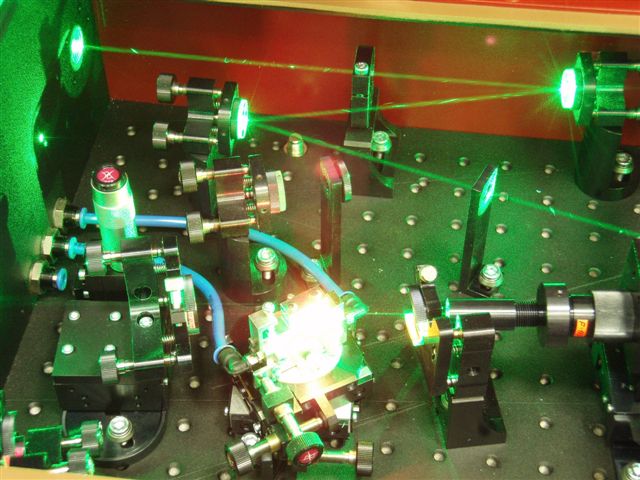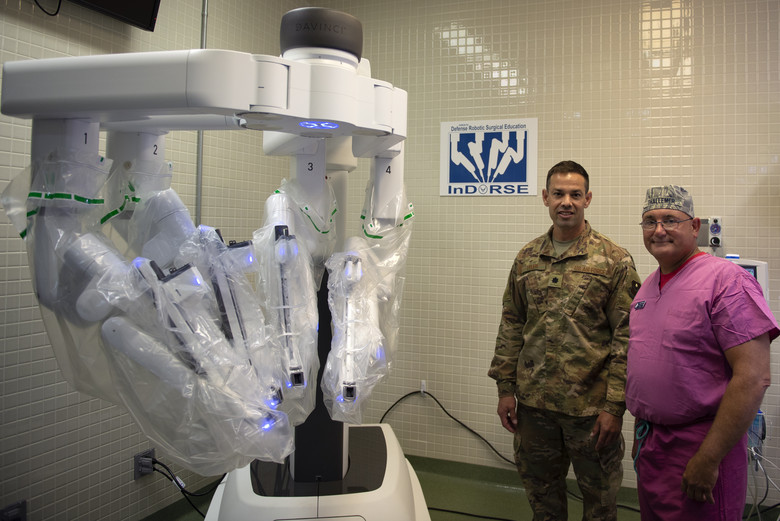
A femtosecond laser: a fine-tuned symphony of optomechanical components and light sources delivering a train of ultrashort pulses – an essential tool in spectroscopy and biological research. Photo courtesy of Wikipedia.
Researchers began manipulating laser technologies to use in scientific research long time ago. Which began as abstract exploration of the behavior of light and its interaction with nature, soon turned into a complete branch of science that we all now know as photonics. As scientists advanced their probing, they learned just how influential photonics is in many scientific discoveries.
Photonics technology quickly spread from the realm of physics to life sciences. Light and laser technologies find use in many stages of medical and biological research. Spectroscopy allows for detailed examination of biological building blocks, which stand to alter the way that we look at diseases. From drug development and delivery, to medical imaging and genomics, and even robotic guidance in surgery, all rely on medical lasers for success.
The technologies discussed in this blog post all influence the progress of modern medicine as we know it. As we speak, these tools are discovering new diseases and new ways to treat them. In this article we will explore the far-reaching influence of photonics on medicine.
#1 – Diagnostic Imaging Devices (OCT, MRI and PET)
Diagnostics is arguably the most heavily affected medical aspect changed by photonics. For instance, OCT scans are a modern advent that can detect a multitude of previously troublesome conditions. The earliest and most impacted area that OCT has benefited is ophthalmology. Eye scans using OCT can detect glaucoma, retinopathy, and other forms of critical optic degradation. The technique has been vital in diagnosing new retinal disorders and is now a staple in every modern optometry clinic.
Similarly, MRI, CT and other imaging methods have also lent themselves to progressing women’s health diagnostics. These eliminate the need for cumbersome and invasive processes, by replacing them with a simple scan. More on this below.
A burgeoning imaging technique called PET (positron emission tomography) relies on advances made in photonics and molecular biology. PET leverages gamma radiation to map metabolic processes within the body, and better trace the origins of a disease. This technique has become particularly useful in cancer diagnostics. Another area that’s found an application for PET is neurology, and drug development for both aforementioned areas. Unfortunately, while PET is less invasive than its CT/OCT counterparts, it still exposes the patient to large doses of ionizing radiation.
#2 – Less invasive procedures for Women’s Health
Women’s health diagnostics have greatly evolved due to photonics, eliminating invasive and embarrassing treatment procedures. The invasive nature of even basic women’s health procedures are a huge deterrent to the early detection and diagnosis of severely deadly illnesses. From regions with wide accessibility to women’s care, to those who are under served, all populations report embarrassment and discomfort as a heavily weighted factor in their decision to seek treatment or visit a doctor’s office.
The most notable imaging tool in this sphere is likely the ultrasound device. This tool assists women’s health in many aspects, from obstetrics, to gynecology, to urology and breast cancer diagnostics. Fluorescence imaging has also played a big part in identifying the biological source of many diseases, particular breast cancer.
This comes in the form of low cost diagnostic devices that make regular checkups easier. Preventative medicine is difficult to achieve when people are disincentivized to attend their regular checkups. The future of photonic medicine leans towards the development of optical biopsy techniques. When these methods fully eliminate discomfort from patients, preventative care becomes a more prominent fix to women’s health problems.
#3 – Surgical guidance and automated medical procedures

This robot is one of many tools that laser technologies guide, used in surgical operations. Courtesy of the USAF Institute for Defense Robotic Surgery Clinical Research Lab on Keesler Air Force Base, Mississippi.
A variety of devices used in medicine are a direct result from collaboration between biotechnology, biomedical engineering and photonics. These devices range from surgical guidance tools, to biomarker detection and other treatment tools. Machine vision technology uses laser scanning to inform the decisions of automated instruments. The most well known of these is likely autonomous vehicles, manufacturing devices and other robotic tech.
However, machine vision tech has permeated the medical space as well, finding its way into many treatment procedures. In its most basic form, this takes the form of tools that use ultrasound, cameras or light based imaging to provide a high quality image to the surgeon as it operates on the body.
In a more advanced form, virtual reality headsets and software provide an extremely realistic training environment for surgeons. This helps surgeons by giving them sensory feedback as they manipulate surgical instruments on a “live” patient. You can read more about VR and machine vision, and the impact it has on surgical training here.
#4 – Biosensors and Biomarkers
Biosensors often allow for in-vivo detection of diseases and disorders, eliminating the need for invasive procedures or scans of any kind. An example of this is the analysis of amyloid beta plaque in the human brain, as a precursor to Alzheimer’s Syndrome. Burgeoning technologies like eye scan, as well as injectable nanoscopic sensors explore the extent of plaque buildup. This is a prominent example, but biosensors are in research stages for many different illnesses including cancer, HPV and even certain heart diseases. Together with photonics and optics technologies they have a great potential of addressing the most impactful diseases on human life.
Finely tuned lasers discover the fluorescence of particles in the body. While light and nanoparticles can locate the presence of biomarkers or injuries, treatments for the latter often activate with light! Researchers deploy nano sized drug mediums in a reaction to certain fluorescent chemicals found in the body. Many devices are made to enter the body and respond to these fluorescent chemicals in order to signify the presence of tumors and other malignancies. Researchers apply the same principles to a reaction for drug delivery. The fluorescent signals can similarly activate the release of a chemical once it reaches the targeted or problem area. Cancer research relies heavily on light based methods of drug delivery and photonic treatment.
Another advancement here is the elimination of the biopsy. This is a common procedure that defines the nature of a tumor, whether or not it is malignant. A variety of methods attempt to use optical imaging techniques to diagnose this issue without the standard tissue sample and lab work. Optical technologies capture the nature of a molecule in an instantaneous manner. Researchers deploying this process within the body, are actively looking for ways to perform a biopsy in-vivo.
#5 – Spectroscopic Devices for Research and Treatment Design
Medical research and drug design are fields that take inspiration from spectroscopic studies. Without progress driven by photonics and optics, this impact would not exist. Quality control processes in food, water quality and many other consumer good need spectroscopy for granular analysis of their properties to indicate contamination. However, spectroscopic analysis has changed the way we view diseases.
Spectroscopy allows for extremely precise views at the way that diseases affect human cells and organic processes. Researchers can study the exact ways that a particular drug, bacteria or virus behave on a cellular level. Part of this comes from the interaction that cells have with light.
The study of genomics addresses root genetic causes of diseases and disorders. Spectroscopy achieves a level of detail that allows for this genomic analysis. as increasingly more scientists consider genomics to be the future of medicine.
Lab testing of biological samples has never been simpler, more in depth or informative than it is today, thanks to spectroscopy.
Conclusion
The role photonics and optics play in modern medicine regularly goes unnoticed. Many don’t understand the intricacies of the medical devices used in even a basic checkup, so it is easy to neglect the technologies underlying such devices.
However, it helps to acknowledge just how photonics permeates just about every hard science, from electronics, to astronomy, and now to medicine. Researchers in these fields are becoming more segmented and specified in their studies. Interdisciplinary subcategories involving optics and photonics are popping up across academics.
It is nearly impossible to perform medical research without utilizing some form of optical or photonic technology. Whether it is a microscope, spectrometer, nanoparticle or material, photonics involves itself inherently.
This post is sponsored by Gentec-EO – Leader in Laser Beam Measurements
